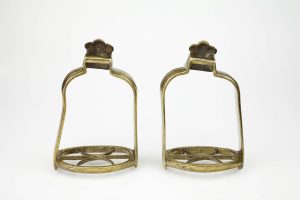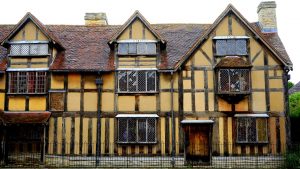In 1592, Richard Fisher, gentleman of Warwick and a man who seems to have been living well beyond his means, noted in his will that he owed over £100 to John Horwood, one of the ‘Yeoman of the Queen’s Stirrups’. This office, new to me, turns out to have been part of the establishment of the Master of the Horse. As Maria Hayward has written in Dress at the Court of King Henry VIII, when Henry died in 1547, one of his royal studs was in Warwick. By 1592, Elizabeth’s main men in the Midlands, Robert and Ambrose Dudley, were both dead but given Robert’s tenure as Master of the Horse and a link between the Dudleys and the Whorwoods/Horwoods, it’s possible that John owed his position to Dudley. As is so often the case when pursuing a particular research strand, the reference from Fisher’s will emerged in the same weeks as a pair of stirrups had come to our attention during a visit to the strong rooms of the Shakespeare Birthplace Trust. We were really looking at saddles, but saddles led to stirrups and Roz Sklar, Museum Collections Officer at the Trust, very generously not only showed us a pair of stirrups in the Trust’s Collection but also told us the story that went with them. The stirrups owned by the SBT are catalogued as being from the early 16th-century and we decided to have a look and see what we could find out. Discussing the stirrups as a group of three was a fascinating exercise in thinking about dating objects and contextualising the narrative that so often goes with them.

Dimensions (H, W, D): 175mm x 115mm x 65mm
The first way of investigating this pair of matching objects is on their own merit, as physical things detached from context and held within the eerie isolation of museum stores. In this regard a continually-expanding schedule of historians have provided instruction. Jules David Prown was one of the earliest of these, among his colleagues in the 1980s E. McClung Fleming and Robert Elliot. Fleming’s model of ‘identification-evaluation-cultural analysis-interpretation’ and Elliot’s model of ‘material-construction-function-provenance-value’ may have survived with less potency than Prown’s simple ‘description-deduction-speculation’, but all three nevertheless get at one central tool available to material culture researchers: haptic analysis. For these stirrups, the act of getting ‘hands on’ – a privilege afforded material culture researchers by the curators of collections – enables us to make valid assertions about their properties which, in so doing, make for more educated and reasonable ‘speculations’ about how there were consumed.
Perhaps the most obvious of these properties is their weight: understanding how the solid, dense metal of the stirrups would weigh down the stiff leather straps which connected them to a saddle, and the pressure they would have exerted when used in this way against the belly of the horse. Secondly, directly handling an object provides researchers with a sense of their texture. In the case of these stirrups despite decorative ridges to the sides of their arches and functional gaps in their base, the surface of the objects are smooth throughout. Finally, moving the stirrups back and forth, tilting them in a range of directions highlights their luminescence; how they respond to changes in light and their bearing to the direction of a light source. By handling these objects, therefore, researchers can get a sense of how they would have been experienced in representational or performative contexts. All three of these elements are revealing insights into objects that, for all the advancements in technology, photographic reproductions cannot provide, and which are also concealed by the necessary but static display of objects in fixed exhibits or displays. By using Prown’s ‘creative imagining’, researchers are able to get a little closer to the contemporary consumption of these objects as we share a human instinct to touch with the subjects of our study.
In The Taming of the Shrew, the servant Biondello remarked ‘Why, Petruchio is coming in a new hat and an old jerkin; a pair of old breeches thrice turn’d; a pair of boots that have been candle-cases, one buckled, another lac’d […] his horse hipp’d, with an old mothy saddle and stirrups of no kindred’ (Act 3 Scene 2). Part of the motivations for Biondello’s statement may have been to cast shade on the more worn elements of Petruchio’s garb, but his comments also directly address the contexts of consumption for these objects. Looking beyond the object itself, this context is the next pit stop for material culture researchers.
What Biondello’s comments of Petruchio really say, therefore, is that items of riding and performance such as these stirrups always exist within an assemblage of other items of clothing and riding equipment. Stirrups were a ubiquitous item of riding apparel, but they were only used in collaboration with a saddle. Quite often, that saddle was also used with a saddle cloth, and steering the horse was facilitated by reins and bridles. At the consumer end, comfortable use of these goods was also dependent on items of clothing: breeches, and more specifically-designed riding boots. When assessing these objects then, either in the flesh at the museum stores or upon reflection back in the office, researchers need to question the other types of object the object of our own focus would be consumed alongside. How would these stirrups facilitate the boots that riders would wear? How would the stirrups visually appear alongside the other items of saddle furniture?

You’ll notice that so far, we haven’t told the story that goes with the Shakespeare Birthplace Trust’s stirrups. Of course, these stirrups were said to be Shakespeare’s. They were apparently found in a cupboard in the Birthplace at some time during the early-mid 19th century and were one of the original items in the object collections of the Trust, alongside Shakespeare’s signet ring and all kinds of objects made from mulberry and emblazoned with the playwright’s coat of arms. The period between 1820 to around 1860 saw the re-invigoration of the genteel Shakespeare first championed by David Garrick in the second half of the 18th century. The apparently chance finding of a pair of stirrups in the Birthplace fits nicely into all kinds of findings made about Shakespeare during this time. The image of William riding home to Stratford from London provides an enduring image of a successful man returning to the town where he now lived as a gentleman.
However, if the gentle Shakespeare of the Victorian imagination was riding home, then it would have been to his own house at New Place and not to the house on Henley Street. The stirrups in the cupboard are yet another example of how the absence of New Place created proxy locations for Shakespeare around Stratford. With no rooms left at New Place for cupboards, a cupboard in the Birthplace was the natural repository for Shakespeare’s stirrups. Nevertheless, the stirrups themselves need not be dated by the date of discovery and may really have been a pair of early modern stirrups, found locally and burnished with a little imagination.
As Roz reflects, “I work with a phantom collection. It is a collection of objects that, for the most part, centre on one man but also have nothing to do with him. We don’t know if any of them were owned by him, we don’t know if he ever saw or touched or smelt any of them. We can’t imagine that any of the marks of wear on them were caused by him. As Cathryn and Tom touch upon – absence is a void into which other things are drawn. And lots of other things have been drawn into the void left by Shakespeare. The museum collection here at the Trust is one of a kind in that regard. Objects to replace objects that no longer exist. And many of the objects stretch the limits of credibility or are known fakes. As curator of this collection I am always aware of the void and I always ask – ‘but was it, really?’ These stirrups are no exception. First – were they really Shakespeare’s? Second, are they really early 16th century in date? Third, if they aren’t, are they fakes (i.e. made to appear as if they’re older than they are), or was the early catalogue description merely the result of hopefulness rather than deceit? I am interested in why that deception or oversight came to be, because that is fascinating and those are the questions worth asking if we want to understand what Shakespeare means to us today.”
The story of the stirrups is just one of many object narratives that makes the items held by the Shakespeare Birthplace Trust a treasure trove not just of objects but of a cultural history that is central to our understanding of the material heritage of Shakespeare in Stratford. Interpreted and transmitted by successive generations as they make their own sense of what Shakespeare means to them, the interaction between stories and objects has created a unique identity for the Trust’s collection.
Cathryn Enis, Research Fellow, Material Heritage of Shakespeare and Stratford-upon-Avon, University of Birmingham
Tom Rusbridge, Doctoral researcher, University of Birmingham
Roz Sklar, Museum Collections Officer, The Shakespeare Birthplace Trust
